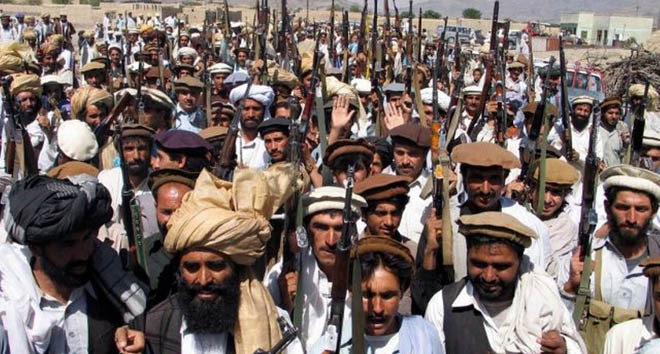
Both tribal and religious in essence, the Taliban militancy mainly emanates from infamous FATA’s special status

In its essence, the Taliban militancy in FATA is both tribal and religious. Either way, it is directed against both the NATO presence in Afghanistan and the Pakistani state. In the former case, the Taliban justify their fight as "jihad" against occupation, in the latter the former allies feel betrayed. In both cases the setting is post 9/11. Ending FATA’s special status is the avenue that promises results.
Pashtunwali is the Pashtuns’ code of conduct. Like the British constitution, it is unwritten. Pashtunwali has various salient features. Two are most pertinent relating to Taliban’s militancy in FATA. These are melmestia or hospitality and badal or revenge. Taliban exploited both to their advantage.
The US-led NATO invasion of Taliban-ruled Afghanistan flushed Muslim militants out of the country. Many among the fleeing militants moved to FATA. They were received as guests by many Pashtun tribesmen though to the dismay of many others. Based on logical deduction, Osama Bin Laden also escaped into FATA in December 2001 and presumably stayed there for the next few years.
The militants were given lodging and boarding facilities at a tribesman’s guest house called hujra. Thus, it should not come as a surprise that almost every drone attack would kill along with militants many people from the host family, hence the so-called collateral damage. Resultantly, the Pashtun Taliban and tribesmen would invoke badal or revenge.
Revenge is retaliation for the murder of a tribesman by another person. Once a murder is committed, the guilty struggles to seek pardon called nanawati or begging for pardon, the most peaceful way to end a conflict among the Pashtuns. The council of elders called Jirga shuttles between the two parties and adjudicates on the issue as per Pashtun traditions. If no pardon takes place the aggrieved family remains in search of an opportunity to kill the killer.
Since drone attacks and Pakistan’s military operations produce collateral damage and no remedy in the form of pardon is carried out, badal is invoked. Many suicide attacks and the militants’ killing spree through other acts of terror speak volumes about this stark reality. The Taliban would have a pool of easy recruits from the surviving members of the victim host family. Moreover, the killing of their colleagues would also provide an opportunity to the militants from other nations and ethnic groups to strike against the Pakistani state to avenge the killing of their comrades.
Since Pakistan was seen as fighting the American war, it was as liable to be targeted as was NATO from across the Afghan side of the Durand Line.
In 2003, the local Taliban in FATA started organising their own armed militias. They were joined not only by the evacuating Afghan Taliban, al-Qaeda operatives and Uzbeks from Islamic Movement of Uzbekistan but also by the Punjabi Taliban. The commonality among all these militants was their sense of belonging to a shared Islamic ideology.
It was in 2004 that we heard of the Mujahideen shuras of North and South Waziristan. In December 2007, Baitullah Mehsud coalesced about 20 militant outfits to form Tehreek-e-Taliban Pakistan (TTP).
The Taliban had two purposes. One, these militant outfits aimed at expelling NATO forces stationed in next door Afghanistan. Baitullah once stated, "America is our enemy and we will fight against it wherever it is possible…the Taliban could not negotiate with Americans as Christians and Jews cannot be friend with Muslims, they are the enemies of the Muslims." Second, the underlying objectives of Pakistani Taliban especially that of TTP’s persuasion have been an end to drone strikes, halting Pakistani military operations and the withdrawal of army from the tribal region and the founding of an ideological polity.
For the Punjabi Taliban and Muslim militants from across various parts of globe, choosing FATA was meant for survival. In the aftermath of 9/11, it became extremely difficult for the Punjabi Taliban to carry out their activities in Indian occupied Kashmir. The time was ripe to hibernate. Some obliged, the fringe groups ended up in North West tribal areas, however.
The Punjabi and Pashtun Taliban felt betrayed and were committed to fight back. So, the blowback effect from past policies was in full swing. Once based in the tribal areas, the Punjabi Taliban developed a nexus with their Pashtun counterpart to wreak havoc. They both had enemies in common: the state and the NATO forces next door.
As the Taliban provided sanctuaries to them in FATA, Punjabi Taliban shared with them their knowledge of Pakistan’s urban centres. The subsequent ferocious attacks in Islamabad, Rawalpindi, Lahore and Multan owned by the Taliban could have never been possible without the intelligence and logistic support of the Punjabi Taliban.
Abolishing FATA’s so called "special status" by bringing it into the national mainstream is long overdue. Pakistani laws minus Frontier Crimes Regulations should be introduced in the tribal region. The region’s status as a launching pad should come to an end.